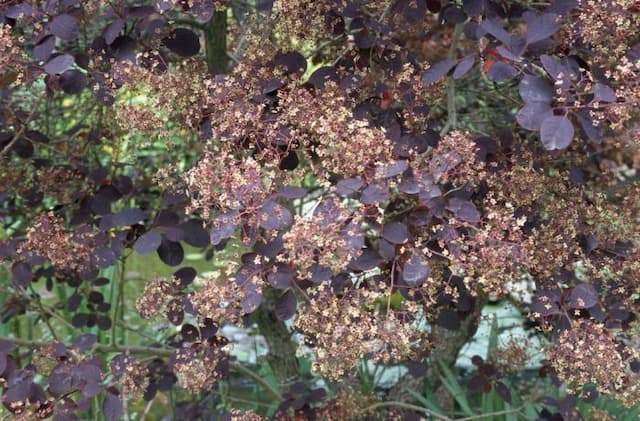Smoke tree Cotinus 'Flame'

ABOUT
Cotinus 'Flame', commonly known as the Smoke Bush, is a captivating deciduous shrub known for its striking foliage and unique cloud-like puffs of bloom. The leaves emerge a bright, fresh green in spring, and as the plant matures through the season, they transform into a spectacular display of oranges, reds, and yellows, mimicking the vibrant hues of a flame, which is how it gets its name. This gradient of fiery colors is most pronounced in the fall, providing a breathtaking autumnal show. In addition to its colorful foliage, the Smoke Bush produces large, airy clusters of minute flowers in the summer. These flower clusters have a fluffy, smoke-like appearance, giving the impression of puffs of smoke that hover above the branches, adding to the plant's dramatic visual appeal. They are usually a soft, misty gray or pink in color, creating a delicate contrast against the bolder tones of the leaves. The bark of the Smoke Bush is also notable — often gray-brown and can become increasingly textured as the plant matures. Its branches form a rounded, spreading habit, with each branch gracefully arching, contributing to the overall elegance of the shrub. The combination of its colorful leaves that change with the seasons, its puff-like blooms, and its graceful branches make the Smoke Bush 'Flame' a celebrated choice for adding a splash of color and interest to any garden space.
About this plant
 Names
NamesFamily
Anacardiaceae
Synonyms
Smoke Tree, Smoke Bush, Venetian Sumac, Flame Smoke Tree
Common names
Cotinus coggygria 'Flame'.
 Toxicity
ToxicityTo humans
The Cotinus 'Flame', commonly known as Smoke Tree, is not known to be toxic to humans. There are no significant reports of poisoning or toxic effects from this plant on humans. However, as with any plant, individual allergic reactions or sensitivities can occur, so it's advisable to be cautious if you are handling or considering ingesting any part of the plant without proper knowledge. Ingesting plant parts is not recommended.
To pets
The Smoke Tree, or Cotinus 'Flame', does not have a significant record of toxicity to pets. There is limited information on its effects if ingested by animals, but it is generally not considered to be poisonous to pets such as cats and dogs. Still, it is always best to prevent pets from eating ornamental plants as they might cause gastrointestinal upset or an allergic reaction in some animals. If you suspect your pet has ingested a potentially toxic plant, consult a veterinarian.
 Characteristics
CharacteristicsLife cycle
Perennials
Foliage type
Deciduous
Color of leaves
Varies
Flower color
Pink
Height
10-15 feet (3-4.5 meters)
Spread
10-15 feet (3-4.5 meters)
Plant type
Shrub
Hardiness zones
5
Native area
Eurasia
Benefits
 General Benefits
General Benefits- Ornamental Appeal: Cotinus 'Flame', commonly known as Smoke Bush, has stunning reddish-purple foliage and smoky, plume-like flowers that add aesthetic value to landscapes.
- Drought Tolerance: Once established, Smoke Bush is fairly drought-resistant, reducing the need for frequent watering and maintenance.
- Seasonal Interest: It offers year-round interest with its vibrant leaves, which turn fiery red and orange in fall, and its distinctive seed puffs in winter.
- Wildlife Attraction: The blooms of the Smoke Bush attract pollinators like bees and butterflies, benefiting the local ecosystem.
- Low Maintenance: Smoke Bush requires minimal pruning and is resistant to many common pests and diseases, making it an easy plant to care for.
 Medical Properties
Medical PropertiesThis plant is not used for medical purposes.
 Air-purifying Qualities
Air-purifying QualitiesThis plant is not specifically known for air purifying qualities.
 Other Uses
Other Uses- Dye Production: The leaves and wood of Cotinus 'Flame' can be used to create natural dyes for fabric, yarn, and paper, often rendering a range of hues from yellow to orange.
- Insect Repellent: The smoke from burning the wood of Cotinus 'Flame' has been said to repel insects, making it useful during outdoor gatherings.
- Photography: The dense, smoky plumes of Cotinus 'Flame' flowers offer a unique backdrop for photographers looking for a natural, dreamy effect in their images.
- Woodworking: The hard, dense wood of this shrub can be used in woodworking projects, providing a unique color and grain pattern.
- Landscape Design: Cotinus 'Flame' can serve as a natural fence or privacy screen due to its robust and bushy growth habit.
- Fish Farming: The wood chips of Cotinus 'Flame' can be used in fish farming to add tannins to the water, which can benefit certain fish species by mimicking their natural environment.
- Fall Foliage Displays: Branches of Cotinus 'Flame' with vibrant autumn leaves can be used in floral arrangements and seasonal decor.
- Erosion Control: Planting Cotinus 'Flame' on slopes can help reduce soil erosion thanks to its extensive root system.
- Culinary Smoking: The wood from Cotinus 'Flame' can impart a unique flavor when used for smoking meats and other culinary dishes.
- Art Supplies: Cotinus 'Flame' twigs and branches can be used in the creation of natural art supplies, like charcoal for drawing.
Interesting Facts
 Feng Shui
Feng ShuiThe Smoke Tree is not used in Feng Shui practice.
 Zodiac Sign Compitability
Zodiac Sign CompitabilityThe Smoke Tree is not used in astrology practice.
 Plant Symbolism
Plant Symbolism- Transformation - The Cotinus 'Flame', also known as Smoke Tree, is often associated with transformation because of its distinctive smoky plumes that appear to transform the foliage.
- Illusion - Its fuzzy, smoke-like flowers give an illusionary effect that can symbolize the mysteries of life or the blurred lines between reality and illusion.
- Beauty and Elegance - With its striking appearance and graceful smoke-like puffs, Smoke Tree represents beauty and elegance in the plant world.
- Vitality - The vibrant autumn colors of the leaves symbolize energy and vitality, as the plant transitions into a brilliant display at the end of the growing season.
 Water
WaterSmoke tree, commonly referred to as Cotinus 'Flame', should be watered deeply to encourage a strong root system, often requiring a thorough soaking of the root zone. For newly planted trees, water them every few days for the first couple of months, providing about 1-2 gallons per watering. Once established, the smoke tree is quite drought-tolerant and should be watered less frequently, approximately once every 1-2 weeks, depending on the weather. During the growing season, in the absence of rainfall, a weekly watering of 1-2 gallons should suffice. Always ensure the soil has dried out before watering again to prevent over-watering and root rot.
 Light
LightSmoke trees like the Cotinus 'Flame' thrive best in full sun conditions, which means they require at least 6 hours of direct sunlight per day. The ideal spot for a smoke tree is in an area that receives unfiltered, full sunlight throughout the day to encourage the best leaf color and flowering.
 Temperature
TemperatureSmoke trees, including Cotinus 'Flame', perform well in a range of temperatures and are hardy in temperatures as low as -20°F, suitable for USDA hardiness zones 4 through 8. They prefer the average ambient outdoor temperature during the growing season, ideally between 60°F and 75°F. Extreme heat above 95°F may stress the plant but typically does not cause significant damage.
 Pruning
PruningPruning the Cotinus 'Flame', or smoke tree, is important for removing dead or damaged branches and shaping the plant. Prune in late winter or early spring before new growth starts. It's usually sufficient to prune once annually during this time. Cut back any overly long or awkward branches to maintain a pleasing shape and remove any dead wood to keep the tree healthy.
 Cleaning
CleaningAs needed
 Soil
SoilSmoke Tree prefers well-drained, fertile soil with a pH ranging from 5.5 to 7.5. A mix of loamy soil, peat, compost, and a small amount of sand or perlite encourages healthy growth.
 Repotting
RepottingSmoke Trees are typically grown in the ground and do not need repotting. If potted, they should be repotted only when rootbound, which is infrequently.
 Humidity & Misting
Humidity & MistingSmoke Trees are adaptable but prefer moderate humidity levels; they do not have specific humidity requirements.
 Suitable locations
Suitable locationsIndoor
Not suitable for indoor growth due to its size and light needs.
Outdoor
Plant in full sun, well-draining soil, and space for growth.
Hardiness zone
5-9 USDA
 Life cycle
Life cycleCotinus 'Flame', commonly known as the Flame smoke bush, begins its life cycle when the seed germinates, usually requiring well-drained soil and warmth. The sprout then develops into a seedling, showing the first signs of true leaves characteristic of the species. As it enters the vegetative growth stage, the plant focuses on leaf and stem development, eventually forming a multi-stemmed shrub with distinct, red foliage. The Flame smoke bush reaches maturity and begins its reproductive phase, producing clusters of small yellowish flowers that give way to the distinctive, fluffy, smoke-like plumes in summer. Over the years, the shrub undergoes senescence, during which growth slows and it may experience reduced vigor until it eventually dies, completing its life cycle. The plant may also reproduce asexually through cuttings, allowing for propagation without seed production.
 Propogation
PropogationPropogation time
Early Spring
The Cotinus 'Flame', also known as the Smoke Bush, is typically propagated via softwood cuttings. This is most effectively done in the late spring or early summer when the plant's new growth is still flexible but not too delicate. To propagate through cuttings, one should select a healthy branch, making a cut to include several inches (convert to 2-6 inches; around 5-15 cm) of the stem. The cutting should have a few leaves left at the top while the lower leaves are removed. The cut end can then be dipped in rooting hormone to encourage root development and planted in a well-draining soil mix. The cutting should be kept moist and in a warm environment with indirect sunlight until roots have established, which can take several weeks. Once roots have formed, the new Smoke Bush plant can be transplanted into the garden or a larger pot for further growth.
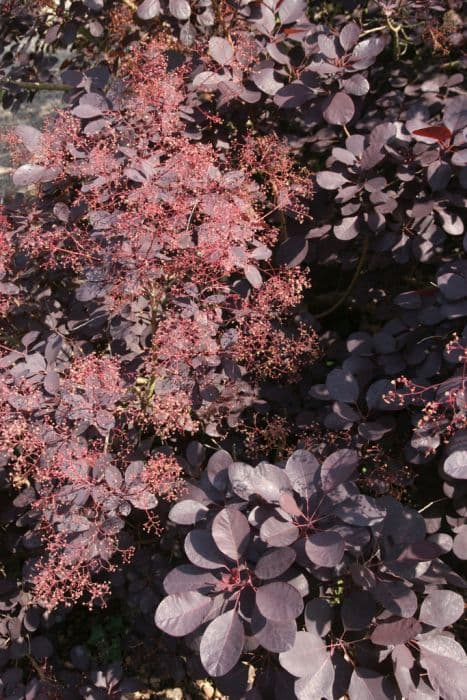

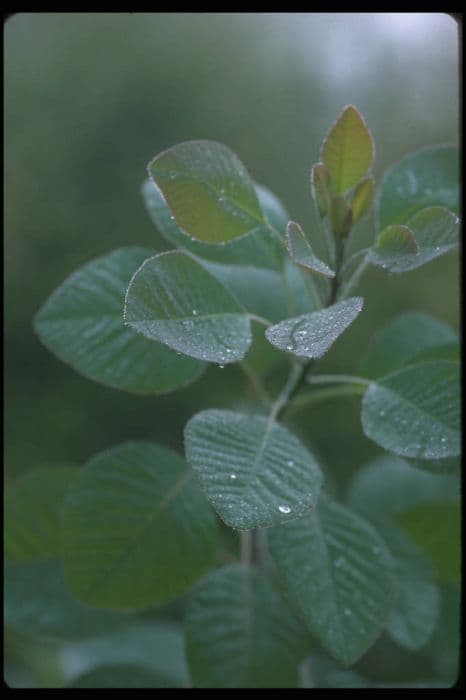
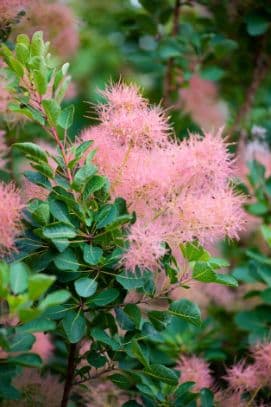
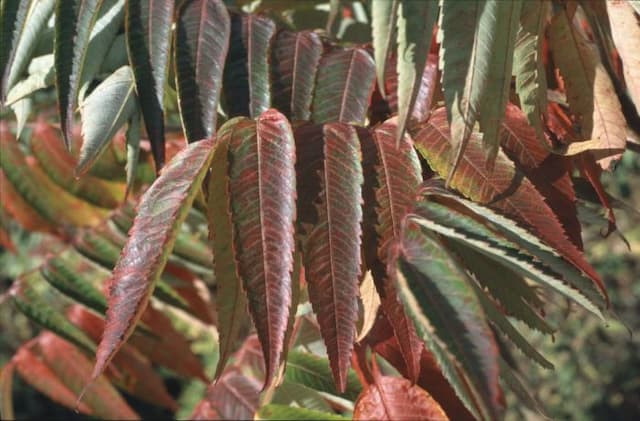
![Smoke tree [Golden Spirit]](/_next/image?url=https%3A%2F%2Fplants-admin.emdemapps.com%2Fimages%2Fplants%2F%2Fimages%2F604b63b450a12.png&w=640&q=75)
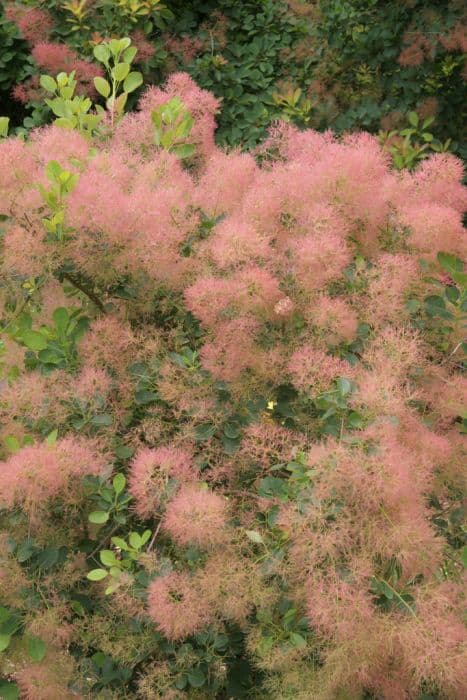

![Stag's horn sumach [Radiance]](/_next/image?url=https%3A%2F%2Fplants-admin.emdemapps.com%2Fimages%2Fplants%2F%2Fimages%2F604b6223f1c1d.png&w=640&q=75)
